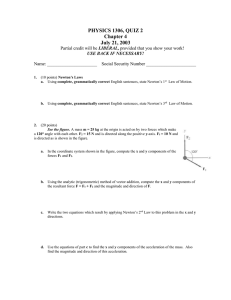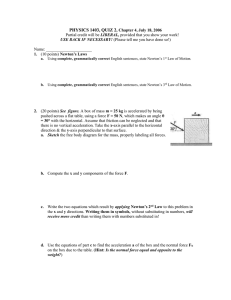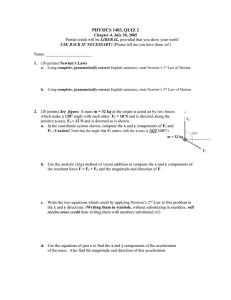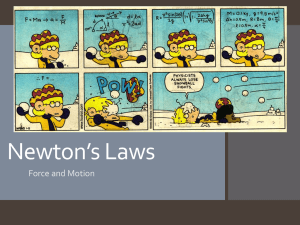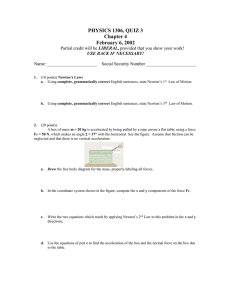Force and Motion–I chapter 5
advertisement
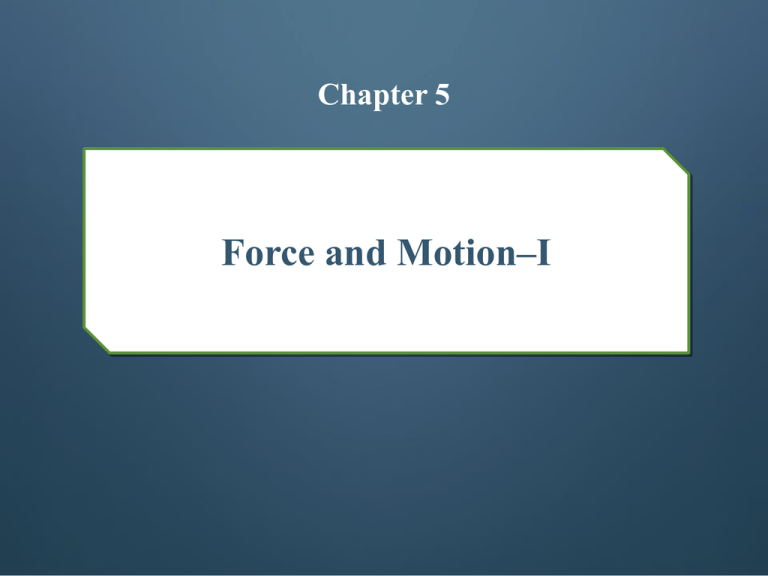
Chapter 5 Force and Motion–I Newton's First and Second Laws A force: o Is a “push or pull” acting on an object o Causes acceleration We will focus on Newton's three laws of motion: o o Newtonian mechanics is valid for everyday situations It is not valid for speeds which are an appreciable fraction of the speed of light o It is not valid for objects on the scale of atomic structure o Viewed as an approximation of general relativity Newton's First and Second Laws Before Newtonian mechanics: o o Some influence (force) was thought necessary to keep a body moving The “natural state” of objects was at rest This seems intuitively reasonable (due to friction) But envision a frictionless surface o Does not slow an object o The object would keep moving forever at a constant speed o Friction is a force! Newton's First and Second Laws Characteristics of forces: o Unit: N, the newton; 1 N = 1 kg m/s2 o Acceleration of a mass is proportional to the exerted force o Forces are vectors Net force is the vector sum of all forces on an object Principle of superposition for forces: o o A net force has the same impact as a single force with identical magnitude and direction So we can restate more correctly: Newton's First and Second Laws What is mass? o o “the mass of a body is the characteristic that relates a force on the body to the resulting acceleration” Mass is a measure of a body’s resistance to a change in motion (change in velocity) o It is not the same as weight, density, size etc. o Mass is inversely proportional to acceleration Example Apply an 8.0 N force to various bodies: o Mass: 1kg → acceleration: 8 m/s2 o Mass: 2kg → acceleration: 4 m/s2 o Mass: 0.5kg → acceleration: 16 m/s2 o Acceleration: 2 m/s2 → mass: 4 kg Newton's First and Second Laws Summarize these behaviors as: As an equation, we write: Eq. (5-1) Identify the body in question, and only include forces that act on that body! Separate the problem axes (they are independent): Eq. (5-2) Newton's First and Second Laws If the net force on a body is zero: o Its acceleration is zero o The forces and the body are in equilibrium o But there may still be forces! Units of force: Tab. (5-1) Newton's First and Second Laws Figure 5-3 To solve problems with forces, we often draw a free body diagram The only body shown is the one we are solving for Forces are drawn as vector arrows with their tails on the body Coordinate system shown Acceleration is NEVER part of a free body diagram – only forces on a body are present. Newton's First and Second Laws Answer: F3 = 2 N to the left in both cases Example 1: A 5 kg body is pushed by a force of magnitude of 20 N. If the body starts its motion from rest, find its speed after 2 s. Solution: 𝑣𝑓 = 𝑣𝑖 + 𝑎𝑡 𝑣𝑖 = 0 𝑎 =? 𝐹 = 𝑚𝑎 𝑎= 𝐹 𝑚 = 20 5 =4 𝑚 𝑠2 𝑣𝑓 = 𝑣𝑖 + 𝑎𝑡 ⟹ 𝑣𝑓 = 0 + 4 × 2 = 8 𝑚 𝑠 Newton's First and Second Laws A system consists of one or more bodies Any force on the bodies inside a system exerted by bodies outside the system is an external force Net force on a system = sum of external forces Forces between bodies in a system: internal forces o Not included in a FBD of the system since internal forces cannot accelerate the system Note: do not confuse a free body diagram of an entire system with free body diagrams of individual bodies within a system. Example 1: If a net horizontal force of 130 N is applied to a person with mass 60.0 kg who is resting on the edge of a swimming pool , what horizontal acceleration is produced ? Solution: 𝐹 = 𝑚𝑎 ⇒ 130 𝑁 = 60 𝐾𝑔 × 𝑎 ⇒ 𝑎 = 𝐹 𝑚 = 130 60 = 2.2 𝑚 𝑠2 Example 2: What magnitude of net force is required to give a 135-kg refrigerator an acceleration of magnitude 1.40 𝑚 . 𝑠2 Solution: 𝐹 = 𝑚𝑎 ⇒ 𝐹 = 135 × 1.4 ⇒ 𝐹 = 189 𝑁 Example 3: A box rests on a frozen pond, which serves as a frictionless horizontal surface. If a fisherman applies a horizontal force with magnitude 48.0 N to the box and produces an acceleration of magnitude 3.00 𝑚 𝑠2 , what is the mass of the box ? Solution: 𝐹 = 𝑚𝑎 ⇒ 48 𝑁 = 𝑚 × 3 𝑚 𝑠2 ⇒𝑚= 𝐹 𝑎 = 48 3 = 16 𝐾𝑔 Some Particular Forces The gravitational force: o A pull that acts on a body, directed toward a second body o Generally we consider situations where the second body is Earth In free fall (y direction, with no drag from the air): Eq. (5-8) This force still acts on a body at rest! We can write it as a vector: Eq. (5-9) Some Particular Forces Weight : The name given to the gravitational force that one body (like the Earth) exerts on an object o It is a force measured in newtons (N) o It is directed downward towards the center Eq. (5-12) Weight Example To relate weight to mass, consider an apple in free fall. The only force on the apple is the gravitational force which results in an acceleration of g. Applying Newton’s 2nd Law Fnet = ma where Fnet = Fg = W and a =g W = mg Thus, Fg = W = mg (mass – weight relationship) Example 1: Calculate the weight of a 70.0kg person on earth and on the moon, where gravity is 1/6 of the earth. Solution: 𝑚 𝑠2 9.8 𝑚 6 𝑠2 𝐸𝑎𝑟𝑡ℎ 𝑊 = 𝑚𝑔 = 70 𝐾𝑔 × 9.8 𝑀𝑜𝑜𝑛 𝑊 = 𝑚𝑔 = 70 𝐾𝑔 × = 700 𝑁 = 117 𝑁 Example 2: A jar weighs 5.0 N. What is its mass? (Homework) Example 3: An 80.0 kg persons weights 765N on top of a mountain. Calculate the acceleration due to gravity on the mountain. Solution: 𝑊 765 𝑁 𝑚 𝑊 = 𝑚𝑔 ⇒ 𝑔 = 𝑚 = 80 𝐾𝑔 = 9.56 𝑠2 Some Particular Forces The normal force: o o If you are standing on a surface, the push back on you from the surface (due to deformation) is the normal force Normal means perpendicular Figure 5-7 Some Particular Forces Example Normal force for a block resting on a horizontal surface that is: o o Accelerating vertically at ay: Vertically at rest: Answer: (a) equal to mg (no acceleration) (b) greater than mg (see 5-13, with positive acceleration) Eq. (5-13) Eq. (5-14) Some Particular Forces Tension force: o A cord (or rope, etc.) is attached to a body and pulled taut o Cord pulls on the body with force T directed along the cord o The cord is said to be under tension o The tension in the cord is T A massless and unstretchable cord exists only as a connection between two bodies o o o It pulls on both with the same force, T True even if the bodies and cord are accelerating, and even if the cord runs around a massless, frictionless pulley These are useful simplifying assumptions Example 1: A constant force of magnitude of 50 N is applied to move a 10-kg stationary (at rest) box over a frictionless floor. Calculate: 1) The speed of the box 3 s later. 2) The normal force on the body. Solution: 1) 𝒗𝒇 = 𝒗𝒊 + 𝒂𝒕 𝑣𝑖 = 0 𝑎 =? 𝐹 = 𝑚𝑎 𝑎= 𝐹 𝑚 = 50 10 =5 𝑚 𝑠2 𝑣𝑓 = 𝑣𝑖 + 𝑎𝑡 ⟹ 𝑣𝑓 = 0 + 5 × 3 = 15 𝟐) 𝑭𝒚 = 𝒎𝒂𝒚 𝐹𝑦 = 0 𝐹𝑦 = 0 ⟹ 𝑛 − 𝑊 = 0 ⟹ 𝑛 = 𝑊 ⟹ 𝑛 = 𝑚𝑔 = 10 × 9.8 = 98 𝑁 𝑚 𝑠 Example 2: A constant force of magnitude of 20 N is applied, at angle of 𝜃 = 𝟑𝟎° above the horizontal, to move a body of mass 4 kg on a frictionless table. Calculate: 1) The acceleration. 2) The normal force on the body. Solution: 1) 𝑭𝒙 = 𝒎𝒂𝒙 𝐹 cos 𝜃 = 𝑚𝑎 𝑎= 1) 𝐹 cos 𝜃 𝑚 = 20 cos 30° 4 = 4.33 𝑚 𝑠2 𝑭𝒚 = 𝟎 𝑛 + 𝐹 sin 𝜃 − 𝑊 = 0 𝑛 = 𝑊 − 𝐹 sin 𝜃 = 𝑚𝑔 − 𝐹 sin 𝜃 = 4 × 9.8 − 20 sin 30° = 29.2 𝑁 Applying Newton's Laws Objects interact when they push or pull on each other: We can write this law as a scalar or vector relation: Eq. (5-15) We call these two forces a third-law force pair Any time any two objects interact, there is a third-law force pair Summary Newtonian Mechanics Force Forces are pushes or pulls Vector quantities Forces cause acceleration 1 N = 1 kg m/s2 Net force is the sum of all forces on a body Newton's First Law If there is no net force on a body, the body remains at rest if it is initially at rest, or moves in a straight line at constant speed if it is in motion. Inertial Reference Frames Frames in which Newtonian mechanics holds Summary Mass Newton's Second Law The characteristic that relates the body's acceleration to the net force Free-body diagram represents the forces on one object Scalar quantity Some Particular Forces Eq. (5-1) Weight: Eq. (5-12) Normal force from a surface Friction along a surface Newton's Third Law Law of force-pairs If there is a force by B on C, then there is a force by C on B: Eq. (5-15) Tension in a cord

